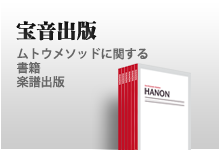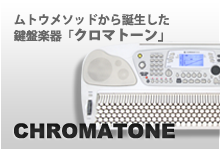The problems with 5 line notation
‘Why has 5 line notation survived ?’
Everybody knows ‘it is not rational’ and ‘it is hard to understand’. ‘Then why 5 line music notation has been kept in use up until today ?’ is the question everyone has. We can be convinced if we look back the history.
When the 5 line notation was born 600 years ago, it was a tool to record notes and to communicate with other people.
Back then, as there was no way to record sound, it enabled to repeatedly perform music as many times as you wanted by writing the music down with signs and symbols. Yes, the purpose of using notation was totally different back then compared to now.
Actually, the music notation is the root of music media such as record and CD. It was used to appreciation of music as media on which the musical notes written down on paper. In Europe back in 16th century, the publication was being rented and sold to the aristocrats who were the listeners, with notation printed on the paper. And apparently the business mechanism copyright management worked by giving the sales revenue back to composers.
Back then, the publishers of notation had a role of current music publishers (*1).
And the music media handled by the publishers developed and evolved to disc media such as record and CD, tape media such as cassette tape and DV, and broadcasting media such as radio and television, after hundreds years since the birth of paper media such as printing. And these years, all the media including paper media is getting integrated thanks to the rapid growth of digital technology into cloud media, as you fully know.
Then why music notation needed to complicate itself to be difficult to understand irrationally ? The answer is;
‘Media always had battles against copyright violation’. (or ‘media always had to maintain copyright protection system’)
As long as the notation is the root of music media, the copy guard function is essential in the notation (the record). The music notation is the printed paper of musical data that are encoded (coded, ciphered) with note, clef, key signature and accidental. As they were traded for music appreciation like record and CD today, it is a music notation method not with the concept ‘for anybody to understand easily’ but ‘for limited people to decode and it is encoded with various signs and symbols.’
‘Who would buy such score that is very hard to read ?’
You may think like that.
Now we try to compare the flow of media to the end users in backwards - now and old days.
Now in the 21st century, listeners buy media.
Media is reproduced by players.
Back in old days, aristocrats purchased scores
Then scores were played by performers and musicians.
The aristocrats back then patronized favorite performers and musicians and let them perform at salon concerts regularly.
In these days, we enjoy music by playing the encrypted song data with iPod.
The score was positioned as encrypted song data now and the performers and musicians back then were like iPod today.
In short, there is no big change in the flow to listen to music even in these days compared to old days basically. We notice that the relationship between Media and Player remain unchanged after hundreds of years, as follows:
Encoded (encrypted) Music Data is recorded onto media such as paper (score) or disc (CD). Then, performers & musicians, CD player and iPod decrypt code to play.
Back in 16th century, the function of score was media to be played for the listeners to enjoy music. Listeners did not care how the media had been encrypted.
However, in these days, listeners do not obtain scores to listen to music. Currently, people use them to read notation and play by themselves, to study music. In the most of the cases, it is not to listen to music, but to play music on their own. By following the logic, it is quite natural to think ‘who would buy such a complicated score ?’
But still 5 line notation is being used now. What is the reason ?
Because the way of thinking of old players still remains, that is being able to read complicated notation with lots of # ,♭ and double sharp (almost encrypted) was highly evaluated. As in the classic music genre, they find values in the old and historical things and keep them persistently as score (music notation) art. That is the major reason why notation method has not been changed during hundreds of years. But at the same time, classic music remains exist as highly valuable music.
(*1) Music Publishers:
In Europe in 16th century, they developed to print and sell music notation. And therefore they got called as ‘music publishers.’ Currently, they manage the musical works, sales and tie-ups which are promotions generally, then they distribute royalties. They manage copyright. These days, the popular music publishers are AVEX Entertainment, Sony Music Artists, Warner Music Japan, etc.
The current music education is wrong.
In general, people believe the thought that we need special training from the childhood and unique talent to be able to play music freely. But is it really true ?
Musical sense is not only owned by a handful amount of musicians. Actually, any person has it equally.
The education method instilled the prejudice in the people, like ‘music is difficult ’. The current music education is based on 5 line notation (= diatonic notation). For example, if you have ever learned piano, you must have experiences like ‘I enjoyed playing piano in the beginning, but I failed suddenly after facing black keys or # and ♭’. There must be the problems clearly as not only a single person but also a lot of people failed at the same point.
Since no one wonders the fact that ‘alphabets starts from A’, not many people wonder ‘why piano has black keys?’ or ‘why 5 line notation uses # and ♭?’ But it is very 5 line notation that pushes us away from music. In the classic music world, 5 line notation is still being used as the most efficient method in the history. As we saw, the background of popularization of 5 line notation was totally different from current situation. Therefore it is natural to face contradictions and problems these days.
Music is not difficult. It just ‘looks difficult’. At first, we need to clarify the misunderstandings in the education sites, that is ‘it is correct to use 5 line notation in the music education’.
5 line music notation was making music complicated.
- If you learn 5 line notation, you will be failed –
If you would like to master music, you cannot avoid 5 line music notation (=diatonic notation).
Everyone makes big efforts to study to be able to read the notation. When we tell them ‘if you learn 5 line notation, you will be failed’, most of them get very surprised. It is natural that no one imagines that 5 line notation has full of problems.
Then why 5 line notation has full of problems ? The reason is that we cannot grasp the distance between the notes correctly. Do you know that whole tones and half tones exist in 1 octave (DO,RE,MI,FA,SO,LA,SI) ?
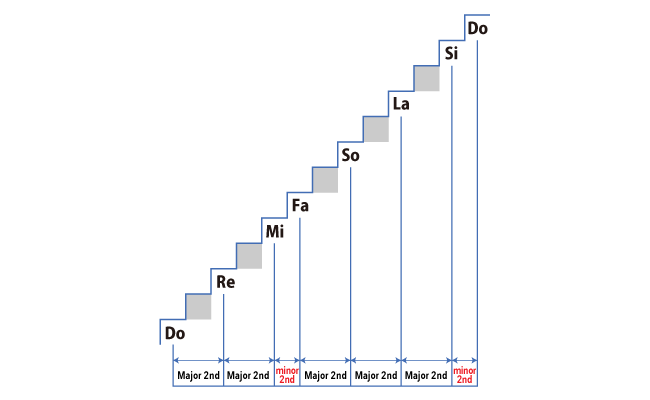
※ Gray part shows the notes assigned on the black keys.

For example, DO & MI, FA & LA, SO & SI are major 3rd. And RE & FA, MI & SO, LA & DO are minor 3rd. Major 3rd and Minor 3rd are different in terms of intervals (distance between notes). But in the 5 line notation, they are indicated as the same distance. [fig.2]
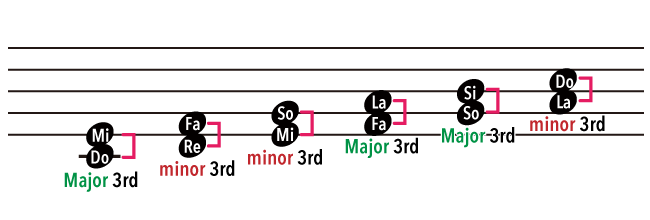
As humans captures image by the sight, it is natural to consider same if indicated as same distance. Therefore, the correct interval in their mind and the image captured by sight create conflict and they get confused. Even some people get sick as they cannot overcome the problem. We can see how unnatural the 5 line notation method is.
Actually, people who do not care about notations improve themselves faster. A lot of top quality successful singers in the music scene cannot read 5 line notation. In their throat, distance between notes like ‘DO, MI, SO’ are very clear. It is essential to have good sense of pitch to control their throat. But if they try to sing while reading notation, DO & MI, MI & SO have the same distance on 5 line notation, but as the real distance between notes are different, they need to sing while calculating in their brain. That is why singers tend to avoid 5 line notation. I heard many professional musicians in overseas countries do not read notation.
Music notation is like a drawing plan or a map.
For example, please imagine a map.
In the precise map, you can see the difference between the place of 100meters ahead and 300meters ahead. If one has that sense of distance, even elementary school student can reach the destination. But 5 lines notation is not like that. If you look at notation, we cannot know which distance is long and which other one is short. For example, suppose DO & RE has 100meters in the distance between 2 notes, MI & FA should be 50meters. However, on the map called 5 line notation, they are both indicated as 100meters.
Also, on the 5 line notation, a lot of signs are used such as G clef, F clef, C clef, #, ♭, double sharp, double flat. [fig.3] In reality, these signs are used to make notation look like complicated unnecessarily, and just to keep consistency for themselves. When they learn to read notation smoothly after memorizing signs like ciphers, they may start thinking ‘Wow, it is great to be able to such complicated signs !’
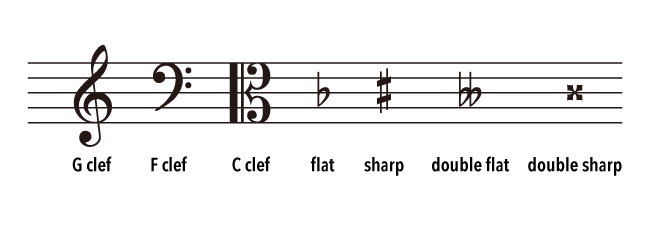
Piano and 5 line notation
The music method featuring piano and education materials based on the current 5 line notation (= Diatonic Notation, ‘5 line notation from here onwards) depends on the music theory that 1 octave has 12 notes and there are 12 major keys and 12 minor keys setting each note as tonic. In 5 line notation, we indicate 12 keys by adding # or ♭. To understand this notation, we need to know about signs attendant to notes such as #, ♭, double sharp. These signs cause confusion. After all, most of the people quit learning piano when 2 to 3 # and ♭ get involved in the notation. In the very beginning, it is fine. But when they need to play with black keys, a lot of people stop playing.
For example, if we change from C major to C# major, 7 #s are added in the notation just to slide up by halftone. The order for the notes to require # is FA, SO, LA, RE, MI, SI. When one # is added, it gets to be G major. And if 2 sharps are added, it will be D major…. (and so forth). C# major needs 7 sharps (see the diagram below).

The reason why we do not understand quickly when told C# major in piano, they write in D♭major. D♭major has 5 ♭. As ♭ is added to the notes in the order of SI,MI,LA,RE,SO, DO,FA, D♭ major has 5♭. Although the scales are same, it is written with # for guitars, while it is written with ♭ for piano, that is strange (see the diagram below).

Because, in the case of stringed instruments including guitars, it is difficult to handle ♭. ♭ is the sign to lower a pitch by halftone. As the characteristic of stringed instruments, it is easy to play notes that are going up. But it is difficult to image the note lower than the open strings, as the lower notes moves to another strings. This is why it is easy to use # in the notation for stringed instruments. It is easy to remember that ‘if 7 # are added, all the notes are higher by halftone’.
But in the music, it has no relation between the fact that ‘4 or 5 # and ♭ are added’ and ‘the tune is difficult.’ We can prove it as anyone can change the keys easily (transposition) at Karaoke. Does it get more difficult when C major (+-0) song is changed to the key of C# major (+1) ?
But when we learn piano with 5 line notation, we get confused to change key by halftone. Therefore , we need to memorize key with 1 #, and key with 1♭, then key with 2 # and 2 ♭, etc. We have to remember all the 12 keys accordingly. This is why it is not good to learn music with 5 line notation. If you study with 5 line notation more, it gets more complicated worthlessly and you lose the musical sense.
The substantial error of 5 line notation is that the intervals between notes are different (not reflecting the reality) on the 5 lines. without knowing it. People cannot grasp the distance between the notes instantaneously.
Moreover, you do not need to have the knowledge of signs like # and ♭ to play music originally. The immoderate examples are double sharp and double flat.
For example, as with double sharp, 2 sharps added, everyone thinks it to raise pitch by whole tone, but it is not in reality. Double sharp is the sign to raise the pitch by halftone. This is designed just to make up the unnatural incompletion. This is the factor that complicates music.
The comparison between 5 line notation and 3 line notation (Chromatic Notation)
Actually, there are many convenient points in using 5 line notation. At first, it looks like complicated. The players feel that they play difficult tunes when the numbers of # and ♭ increase. In reality, the notation with double sharp looks awesome. The players look noble if they can play the notation that seems to be complicated. It is very true in the current classical music society, the professors try to teach in difficult way on purpose.
For example, with Muto Chromatic Keyboards (Rapian, Wholetone Revolution, Chromatone), when you play the same phrase with same fingering at the different positions on the keyboard, it will sound like a tune. In Muto Notation method, like the case of ① and ②, if the phrase is same even though the pitch of the note changes, the indication will be the same and the fingering form will be the same. It is relatively easier in reading and playing. (See the diagram below)

However the notation suddenly gets too busy to read with a lot of # and ♭ when we try to write it down to 5 line notation. ① and ② are the same phrase but just transposed ones, yet they look like different phrases in 5 line notation. But it looks like you must feel you are playing a difficult tune. (See the diagram below)

As a characteristic of 5 line notation, ‘the differentiation in the indication of black keys and white keys are similar to piano’. If no signs are added, they are DO, RE, MI, FA, SO, LA, SI, DO (white keys). There is exceptional case, but if # and ♭ are added, they are mostly black keys.
But the compatibility between piano and 5 line notation is not good.
Because, piano is the instrument that shows 1 octave obviously.
In the case of 5 line notation, it looks like there is good compatibility with piano within the field of 5 lines. But when notes go over 5 lines or below 5 lines, it gets very hard to understand (see below diagram).
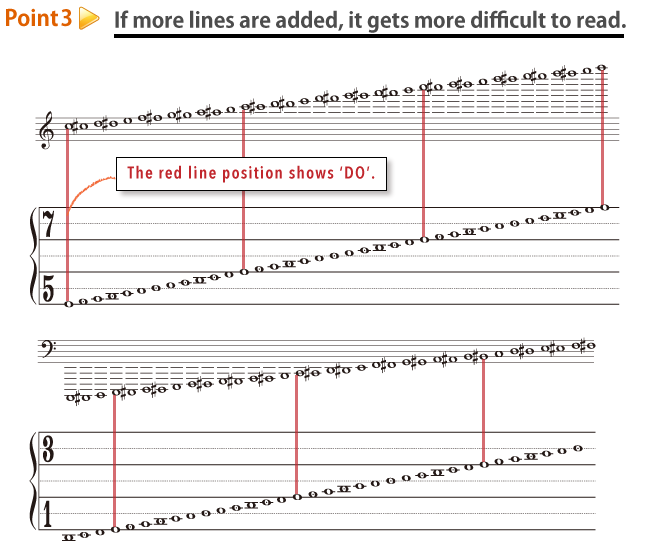
After memorizing 1 octave, it is easy to understand how to play piano, as the keys are positioned in the same manner.

Absolute Pitch and Relative Pitch
Then can we memorize the notes by hearing ? There are problems with that way. Because we memorize the note as fixed DO. You memorize it without any exception. If the children memorize the notes in that way, when they get to know ‘this is LA♭’ by hearing, they would look like genius. As the teachers praise them, they would learn much more. Once they are imprinted in their brains, they would not be able to delete the absolute pitch during all their lives. After they graduate music colleges, most of them tend to be a school teacher or teach at private music schools, as only one out of a few thousands stay in the music industry actually. They only teach what they learned and the people can become school teachers when the ministry of education gives a permission, despite their musical ability or knowledge. Those teachers educate children and they lose musical sense … This ‘misunderstanding spiral’ is occurring as vicious circle in the current music education.
It is ideal that people master both absolute pitch and relative pitch, but usually people only master absolute pitch and finish there. If someone has absolute pitch, it is a useful ability as hearing professional because they can write the tune into notation by listening to them. The relative pitch also makes it possible to do so when they get to know the key. If they know both, they can write notation in C major without adding 3 or 4 # or ♭.
Absolute pitch recognizes as ‘the note is that note absolutely,’ which is so called ‘fixed DO.’ But relative pitch is the person who can recognizes all the notes relatively once the base note is determined. First they adjust to the base and they can write notation as ‘DO, RE, MI…’ from there. That is movable DO. It is correct approach in music originally. Therefore, although absolute pitch looks great for non-professionals as they can specify the note heard randomly, objectively speaking it contains negative factors. A lot of music college students have absolute pitch. When trained during the period from baby to 4 year old, they are fully imprinted. If they find out-of-tuned notes (even slightly), they start feeling sick. For example, if absolute pitch memorizes notes in the colors like DO is red, MI is yellow and SO is blue, a phenomenon happens like every time they see yellow thing on the street, they hear the sound of MI unconsciously. However it is better to have absolute pitch in the music education. Moreover, in the classical piano society, they almost never ask like ‘play tune at E major with lowering the key by halftone from F major’ for example. Because they believe F major is the best key for that tune. And they have another tune for E major. For your reference, there is note of A in the International Standard Pitch that is used in the Orchestra, etc. The sound is LA. But this gets higher every year. Probably the age requires it or we must feel it as most comfortable sound now. Also, as it was not equal temperament used for tuning back in old days, they wrote tunes by searching for the notes that sound best among various tuning methods. They say Bach really cared it in composing the tunes.
*MEMO*
Absolute Pitch and Relative Pitch
Absolute pitch is the ability that enables to grasp the specified note without comparing with other notes. They can tell precisely the randomly played instruments’ note and ‘ warning sound’ of signals, and specify if it was DO or FA, etc. That is a characteristic of absolute pitch. On the other hand, relative pitch is the ability that can recognize as ‘a note higher by one whole tone from DO’ when they listen to RE after listening to DO. Originally, it is ideal to have both absolute pitch and relative pitch. Just for the reference, the book called ‘Absolute Pitch’ written by Hazuki Saisho became a best seller in 1999, that is non-fiction analyzing the mystery of absolute pitch scientifically and musically.
International Standard Pitch
Pitch is oscillating note in the air per second. It is expressed in the unit of Hz (hertz). As it developed the collaborative performances, they find the necessity of setting the certain pitch in the performance, the international conference to determine the international standard has been set up since 1858.



